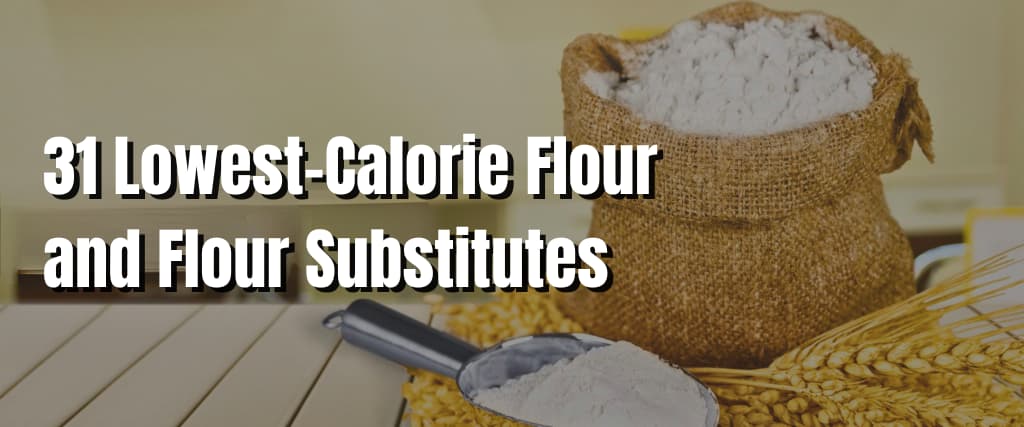Many foods and tasty recipes call for flour as an ingredient. However, those trying to reduce their caloric intake might want to pass on items made with flour.
Now more than ever, you can find alternatives to traditional flour with fewer calories and higher nutrients. White flour isn’t the only option for your culinary endeavours anymore.
Some of the lowest-calorie flour products are presented here. It has also shed light on whether or not they are a nutritious choice and how they may be incorporated into other dishes.
Is Low-Calorie Flour a Healthier Alternative?
Simply put, low-calorie flour is just flour with fewer calories than alternatives. Due to individual differences in calorie requirements, you and I will understand ” low-calorie ” differently.
You could avoid flour entirely if you’re on a strict calorie-counting diet. But several choices have yet to consider that may fit your calorie targets. For instance, for every 100 grams, Seriously plain flour has just 199 calories.
However, is a Low-Calorie Flour a Healthier Alternative?
The opposite is true. A meal’s calorie count is just one indicator of its overall nutritional quality. Calories are an apparent factor to consider while attempting weight loss.
However, the quantity and quality of the product’s nutrients are the most essential factors in determining its healthfulness.
It is possible for a flour or flour replacement to have minimal calories but a high concentration of empty calories.
Compared to almond flour, simple white flour contains around half the calories. Almond flour, on the other hand, has twice as much protein and is a fantastic resource for excellent healthy fats. It has a lot less sugar and a lot more nutritious fibre.
In addition, almond flour is a good source of healthy fats, magnesium, and vitamin E. Almond flour, which has many health advantages but isn’t included here since it has around 611 calories per 100 grams, is one of my favourite flour.
White flour lacks nutritional value since the bran and germ were removed during manufacturing. The remaining endosperm is the starchy component that improves the flour’s gluten content.
Nutrients are added to most foods made with refined flour. This indicates that the producers have replaced synthetic equivalents with one or two natural vitamins and minerals. To put it another way, it’s a promotional instrument!
As a dietitian, I tell my patients to consider the flour’s nutritional value in addition to its caloric one. In light of the above, using low-calorie flour is only sometimes preferable.
Important:
Think about the flour’s complete nutritional profile before buying. How sophisticated is it, if at all? How about protein and fibre content?
Buying Guides For Low-Calorie Flour
1. Gluten-Containing Or Gluten-Free

You should start your search for flour by deciding whether you need a gluten-free or gluten-containment product.
If you have a gluten intolerance, perusing the gluten-contain section wastes time. Instead, you should immediately start using gluten-free flours that are low in calories. Oats, maise, brown rice, quinoa, etc., are good examples of such grains.
On the other hand, if you’re on a gluten-free diet, you may still use all-purpose or whole-wheat flour.
2. Hard-Flour Or Soft-Flour
Hard flour often has a protein content of 12% or more excellent, whereas soft flour averages 7%. Hard flour has a rougher and grittier texture.
In addition, when baked, bread made with hard wheat yields more gluten, making it a better option. Soft flour, conversely, is less prone to generate gluten, making it ideal for cakes and pastries that need a delicate, sensitive crumb.
3. Type Of Flour
The flour used may affect structure, texture, and flavour. Banana bread, for instance, calls for all-purpose flour but not cassava flour due to the latter’s thicker design. Therefore, you should check the recipe to see what flour is required.
4. Calorie Count
If you want to find the healthiest flour options, you should check their calorie counts. Remember that the term “low-calorie” may have many connotations. Before making drastic lifestyle changes, consider your individual calorie and nutritional needs.
Lowest-Calorie Flour And Flour Substitutes
We’ve done the legwork for you and compiled a list of items you may purchase in large shops or your local health food shop if you’re searching for a lower-calorie flour or flour alternative.
The list includes both conventional wheat flour goods and wheat flour alternatives. Substitutes for wheat flour are known as flour substitutes. In addition to being gluten-free, many flour alternatives are also high in nutrients.
We’ve compiled a list of the 12 healthiest flours and flour alternatives here. Remember that the calorie and nutritional value might vary from brand to brand, so it’s essential to check the labels carefully.
1. Seriously
This flour’s foundation is made of coconut and sweet potato flour, making it gluten-free. It may be substituted with regular self-raising flour in baking at a 1:1 ratio.
At only 119 calories per 100g, this flour has one of the few calories available. It includes less than 2g of sugar per serving and is an excellent source of fibre.
Remember that this is a processed good; ingredients like guar gum, xylitol, and psyllium husk can cause gastrointestinal distress in some people.
2. Lupin Flour

Lupin, a legume, has 322 calories per 100g and is a fantastic low-calorie flour alternative.
Additionally, it is gluten-free, rich in protein, and a fantastic source of dietary fibre.
Lupin flour is yellow and has a light nutty flavour. Although it can be used for baking, it works best when combined with another flour or substitute, like a mixture of half lupin and half almond flour.
Lupin is not a suitable flour for those following a low-FODMAP diet since it is in the same group as peas and beans.
3. Macro Organic Flour
This is unprocessed whole wheat flour. Allowing it to age naturally and bleach without chemical agents like benzoyl peroxide is preferred.
The fact that it’s created with 100% whole grains rather than white flour, so some of the beneficial elements will be kept intact.
For convenience, the flour is bleached before use. However, this flour may now be used in sweet and savoury dishes thanks to a triple shift.
This product may contain undetected wheat or gluten.
3. Buckwheat Flour
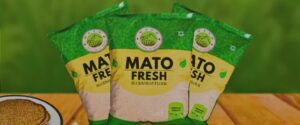
One of the customers’ favourite flour alternatives is buckwheat flour, high in beneficial minerals, including fibre, protein, magnesium and copper.
Buckwheat is created from seeds, despite its name, which suggests that it must include wheat. As a result, it’s a great gluten-free flour to use alone or in combination with other flour.
4. Mckenzie’s Flour
Wholemeal Spelt flour is an excellent option if you’re not celiac, gluten intolerance or wheat-sensitive but find that flour-based items make you feel bloated.
Since spelt flour has a weaker gluten framework and more fibre, it is often easier for me to digest.
Spelt is an old grain that tastes and smells nutty. Protein, fibre, and minerals like iron and zinc may all be found in this gain.
Spelt flour may be used for regular flour in any recipe.
There may be traces of wheat and gluten in this product.
5. Green Banana Flour
 This low-calorie flour has emerged as a wholesome and widely used substitute for traditional flour. It helps keep blood sugar steady and keeps the intestines healthy, two things I like. The glycemic index of this food is relatively low.
This low-calorie flour has emerged as a wholesome and widely used substitute for traditional flour. It helps keep blood sugar steady and keeps the intestines healthy, two things I like. The glycemic index of this food is relatively low.
For maximum resistant protein content, consume uncooked such as smoothies. You may use this as a substitute for wheat flour to avoid gluten.
6. Vetta Smart Flour

This flour has more protein and less carbohydrates than regular flour. The oat fibre addition additionally boosts the already high levels of dietary fibre.
You should know that different flour options are healthier.
In addition to its nutritional merits, this product’s ownership of and production in Australia and its involvement in local community projects via its association with Rural Aid are also noteworthy.
There may be traces of gluten and wheat in this product.
7. Cassava Flour
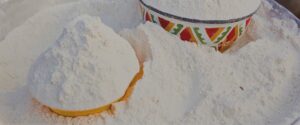
Another option for wheat flour that includes resistant starch and hence nourishes your gut flora is cassava flour.
Cassava flour is a by-product of root veggies and is a gluten-free alternative to other flours. Additionally, it is grain-free.
8. Baker Plain Flour

This conventional wheat-based plain flour has been fortified with thiamine and folate.
It has 347 calories, which is neither the lowest nor the most significant amount. But it surely won’t rate high on the list of nutrients.
Statements like “for strong bones and teeth ” and “enriched for healthy bubs and mums” included in the product’s marketing are misleading.
Includes gluten and wheat, which is an allergen.
9. Coco Lentil Flour
This flour substitute, made from lentils, is a healthy and flexible option. Coeliacs and those with wheat or gluten sensitivities have another alternative since it is gluten-free and wheat-free.
The raw flavour of lentil flour is somewhat bitter, but it cooks down to an earthy flavour. It may be used as a substitute for up to 25% of regular flour in savoury and sweet recipes.
Please be aware that lentil flour is a high FODMAP meal.
10. Bread Flour
Calories in bread flour are much less than in all-purpose flour. It’s a key ingredient in making fluffy, flavorful yeast bread.
Because of its high gluten content, it is essential in producing elastic and crunchy bread dough.
For a chewier end product, like pizza dough, use bread flour instead of all-purpose flour. Avoid using it in baked goods that should be light and airy.
11. Corn Flour

Low-calorie alternatives like corn flour are fantastic. It’s a gluten-free flour, so it’s safe for anyone with gluten sensitivities or allergies.
However, corn flour inhibits the dough’s ability to rise, so avoid using it in baked goods.
In addition, even a tiny amount of maise flour makes for a substantial batter. To attain the right consistency when subbing corn flour for all-purpose flour, use 1/2 cup of corn flour for each mug.
12. Sorghum Flour

Because of its versatility and resemblance to all-purpose flour, sorghum flour has gained popularity in gluten-free and low-calorie baking.
Sorghum improves the texture of baked foods by giving them more structure and stiffness. It gives fried and baked goods an appealing crunch.
It’s important to remember that sorghum flour may provide a sour flavour to baked goods. Bakers often recommend combining sorghum flour with other flour, such as potato starch or rice with sugar flour.
13. Arrowroot flour
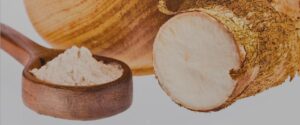
If you’re looking for gluten-free flour or powder, go no further than Arrowroot, which solely contains arrowroot starch.
It has many carbohydrates but few calories, proteins, or fats. It’s used to make the batter more wet, thicker, and able to hold together better.
In addition to its usage as a low-calorie flour alternative in desserts like puddings, cakes, and muffins, arrowroot flour can be used instead to thicken savoury meals like chilli sauces and spaghetti sauce.
Thickening sauces, soups, and the like using flour are possible, but only after creating a slurry with the flour. If you add arrowroot to the hot mixture, it will transform into a giant blob of jelly.
14. Potato Flour
Consider using potato flour to bake tasty, long-lasting bread with a subtle potato flavour. An alternative to wheat flour, it’s manufactured from dehydrated potato peels.
Potato flour is very close to, but different from, potato starch. Drying the potato from top to bottom yields potato flour, whereas collecting the starch from mashed potatoes yields potato starch.
Because it absorbs and retains moisture, potato flour makes baked goods more moist. A tiny quantity may be used to improve the texture of the crumb in gluten-free baked items.
It improves the workability of yeast dough when added to all-purpose bread or whole wheat flour. It’s a common ingredient for thickening sauces and broths.
15. Semolina Flour
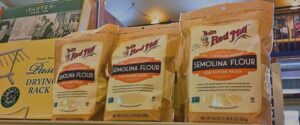
Semolina is a refined form of durum wheat that is low in calories. It has a more earthy scent than regular flour and is coarser, darker, and yellower in colour.
Semolina is typically used to produce pasta and couscous, thus its other common names in Italy: pasta wheat and macaroni wheat. Semolina’s high gluten content makes for more robust pasta.
In addition to pasta and couscous, semolina may produce a tasty bread crust and exquisite puddings, cakes, and pies.
16. Rye Flour
Rye berries, or entire rye kernels, are crushed to make rye flour. The flavour it gives baked items is acidic and nutty.
Products made with this flour may not rise as much as they should because of its low gluten content.
Rye flour may provide a thicker bread batter and trickier dough while baking bread. Its soft texture makes it perfect for baked goods like cookies and biscuits that shouldn’t be chewy.
Rye flour has a high moisture absorption and retention rate. For this reason, baked goods prepared with rye flour tend to stay longer than their all-purpose flour counterparts.
17. Barley Flour
The barley plant produces a nutritious alternative to wheat flour known as barley flour. Its taste is mild and somewhat nutty.
Its low gluten content may be used to tenderise baked goods without hindering the dough’s ability to rise. Barley bread, which is crunchier and has more flavour than white bread, is often made using this ingredient.
Muffins made with barley flour are more moist and soft than those made with all-purpose flour, but they are also less substantial and easily break.
18. Kamut Flour
This wheat cultivar dates back thousands of years and is revered for its high protein and low-calorie content and its silky, buttery, nutty taste.
Bread, muffins, pastries, cookies, crackers, and pancakes all benefit from its rich buttery and almond flavour.
To substitute Kamut flour for all-purpose flour in recipes, measure out 3/4 cup of Kamut flour for every 1 cup of all-purpose flour.
Wheat grains themselves may be used in salads after being soaked. Pasta made from Kamut wheat is among the best available.
19. Whole-Wheat Flour
The whole wheat kernel is ground into flour for making whole wheat flour. The germ and bran of the wheat kernel are included; thus, the flour is darker in colour and has a more robust, nuttier taste and more nutritional content.
Whole wheat flour has less gluten growth and flexibility than all-purpose flour due to the presence of bran and germ. Because of this, whole wheat bread is not as light and fluffy as white bread.
To maximise the flavour of your baked products, combine nuts and fruits with whole wheat flour.
20. Peanut Flour
In place of regular flour, peanut flour is a terrific low-cal option. It’s high in protein and fibre while being low in calories.
Peanuts are ground into a paste, the oil is extracted, and the remaining paste is dried or roasted to produce this flour.
Since this is legume flour, the dish’s flavour will be altered slightly; however, peanut-flavoured baked goods sound pretty good, do they?
Peanut flour is perfect for making light, airy pastries because of its fine texture. It won’t make your baked items thick or heavy, and the surface is identical to regular flour. It may be swapped out for any other flour by a one-to-one ratio.
21. Sunflower Seed Flour
Crushing sunflower seeds into a satisfactory powder yields sunflower seed flour.
Sunflower seed flour has a mild, nutty, and somewhat sweet taste. The mildness of the flavour ensures that it won’t compete with the other ingredients.
It makes for a light, smooth, moist batter and adds extra weight to baked items. It’s equally effective in savoury and sweet applications. The nutty flavour of sunflower flour is highlighted in delicious recipes, while the sweetness is highlighted in sweet ones.
It is a 1:1 replacement for all-purpose flour.
22. Gold Medal
Experts recommend this all-purpose flour first. It’s always in stock at many supermarkets and may be ordered online. It’s the go-to for many bakeries, and for a good reason: it’s cheap!
Because of the gluten content and the combination of soft and hard wheat in this product, it may be used to make anything from bread to cakes. It offers 333 calories per 100 grams, less than many other brands of all-purpose flour.
Please be aware that this item contains gluten. You should explore elsewhere if you need a gluten-free alternative.
23. 365 Whole Flour
For individuals who prefer natural ingredients, this flour is an excellent choice. It contains beneficial nutrients, including fibre, protein, minerals, and vitamins. The fact that it doesn’t include any genetically modified organisms (GMOs) should reassure you that it’s high-quality and safe to use.
There are over 366 calories in every 100 grams. Since whole wheat flour already contains a high amount of gluten, it can be used to make dough for products that need to stretch, like tortillas, rotis, wraps, etc. You won’t believe how fantastic the nutty flavour of this flour is.
The gluten content of whole wheat flour has already been remarked upon.
24. Food To Live Flour
This flour is a fantastic choice if you are looking for a vegan alternative. It’s made from non-GMO, organic barley and has been shown to improve digestion, help with weight reduction, and lower cholesterol levels.
With a maximum of 327 calories per 100 grams, this flour is astonishingly low in fat. Barley still contains gluten, but with 5-8%, it’s a better option for individuals seeking to cut down on gluten intake than soft wheat flour, which contains 20%.
However, some recipes, like sugar cookies or Chapatties, may turn out poorly with this flour. When picking out your ideal flour, keep this in mind.
25. Tru-Nut Peanut Flour
When it comes to satisfying peanut lovers, Tru-Nut Peanut Flour is unrivalled. Most importantly, it’s made entirely of organic ingredients, so you can enjoy the sweetness without adding more sugar.
It’s great in pancakes, waffles, cookies, smoothies, and other dishes. This product is a godsend for those with a sweet appetite but trying to limit their sugar consumption.
This flour has a greater calorie count than many refined peanut flour products because of its high protein content. Specifically, every 100 grams has 521 calories.
26. Big Green Flour
For individuals who have to avoid gluten, sorghum is a fantastic alternative since it is a grain that contains none. The B vitamins found in abundance there are essential for proper metabolism and the development of healthy nerve cells.
This product is made entirely from certified organic sorghum and has no genetically modified ingredients. The 366 calories per 100 grams are fewer than most commercially available foods.
Numerous cookie, cupcake, scone, and other baking recipes can be used. However, it may not be ideal for bread because of the dense texture it produces.
27. Healthworks Coconut Flour
This four is made from 100% pure coconut flesh so that it won’t alter the flavour of your baked goods.
The protein and fibre content of this alternative flour is relatively high. In addition, the product’s component profile makes it suitable for ketogenic, gluten-free, grain-free, vegan, and paleo diets. Therefore, you can use it regardless of what kind of diet you’re on.
This flour may have more calories than other items but is still nutritious. Since the manufacturer uses only fresh ingredients, the product’s colour may change slightly from batch to batch.
28. Otto’s Natural Cassava Flour
Is a low-fat alternative what you’re looking for? Remember to use this flour. This product has no saturated or trans fat, as shown by its zero-gram fat content. This makes it the optimal option for people trying to limit their fat consumption.
Cassava, a kind of root vegetable, is used in its production because of its various beneficial elements. Amazingly low in calories (343 per 100 grams), it can be used as a grain-free substitute.
Baked goods, spaghetti, and pizza bread benefit most from the flour’s constituents. However, the texture might be better for baked goods like banana bread or bread loaf.
29. Bob’s Red Flour
On this list, This flour has the highest price tag. You’ve undoubtedly heard that quinoa is good for you. It has more fibre than other cereals, which may help those with health issues, including high cholesterol and blood pressure.
There are 357 calories in every 100 grams of this flour. Products made using quinoa flour have a soft, moist crumb. However, the nutty, earthy taste of quinoa flour may put some people off.
30. King Arthur Almond Flour
If you’ve been waiting for a flour alternative that has the potential to enhance the flavour of your dishes, your day has come. It will give your baked products a richer flavour and creamier texture since it is made from finely ground blanched almonds.
It’s as at home in savoury pie crusts as sweet cookie doughs. With only 600 calories per 100 grams, this flour is one of the healthiest choices. It’s a huge first step toward a healthy lifestyle if you include it in your eating habits.
The only real complaint we have is with the pricing structure. The high quality of the product justifies the high cost.
31. Arrowhead Mills Flour
This flour is the answer for those who find the aftertaste of low-calorie flour replacements unpleasant.
Even though this flour is prepared from 100% organic oats, there is no lingering oat flavour. You can be confident that every dish you try will be healthier than the original and retain its delicious taste.
It provides more protein and fewer carbs than other basic flours. It’s a terrific addition to your diet since you’ll receive 400 calories for every 100 grams.
Please note that this item is not suitable for those with gluten sensitivities. If you suffer from an allergy or celiac disease, you should avoid it.
Final Verdict
More and more alternatives to white flour appear on grocery store shelves, providing health-conscious consumers and those watching their calorie intake additional choices.
Some of the best low-calorie flour and flour substitutes are included below. Since flours vary in calorie content, reading the nutrition label before using the product is essential.
Finally, trying out flour substitutes like green banana flour, lentil flour, and spelt flour is a good idea. Mixing up your components may increase your exposure to various nutrients and increase the likelihood that you’ll discover a healthy alternative that you’ll eat.
Frequently Asked Questions
Is There A Low-Calorie Alternative To Flour?
Yes. When discussing alternatives to wheat flour, the phrase “flour substitute” is often used. Flour alternatives like lupin flour, banana flour, coconut flour, and many more are widely available.
Does Oat Flour Have Fewer Calories?
No. Contrary to popular belief, compared side-by-side, oat flour has more calories than all-purpose flour.
Oat flour has the nourishment of whole grains since it is processed from the entire oat. To be more specific, there are 389 more calories in 100 grams of oat flour than there are in 100 grams of ordinary flour.
What Flour Is the Lowest In Fat?
If you’re watching your fat consumption, use whole wheat flour since it has zero grams of fat per serving. It’s also a good source of protein, fibre, and other vitamins and minerals.
Whole wheat flour may be used in a weight reduction diet. Celiac and gluten-intolerant people should exercise caution before consuming this since it contains gluten.

